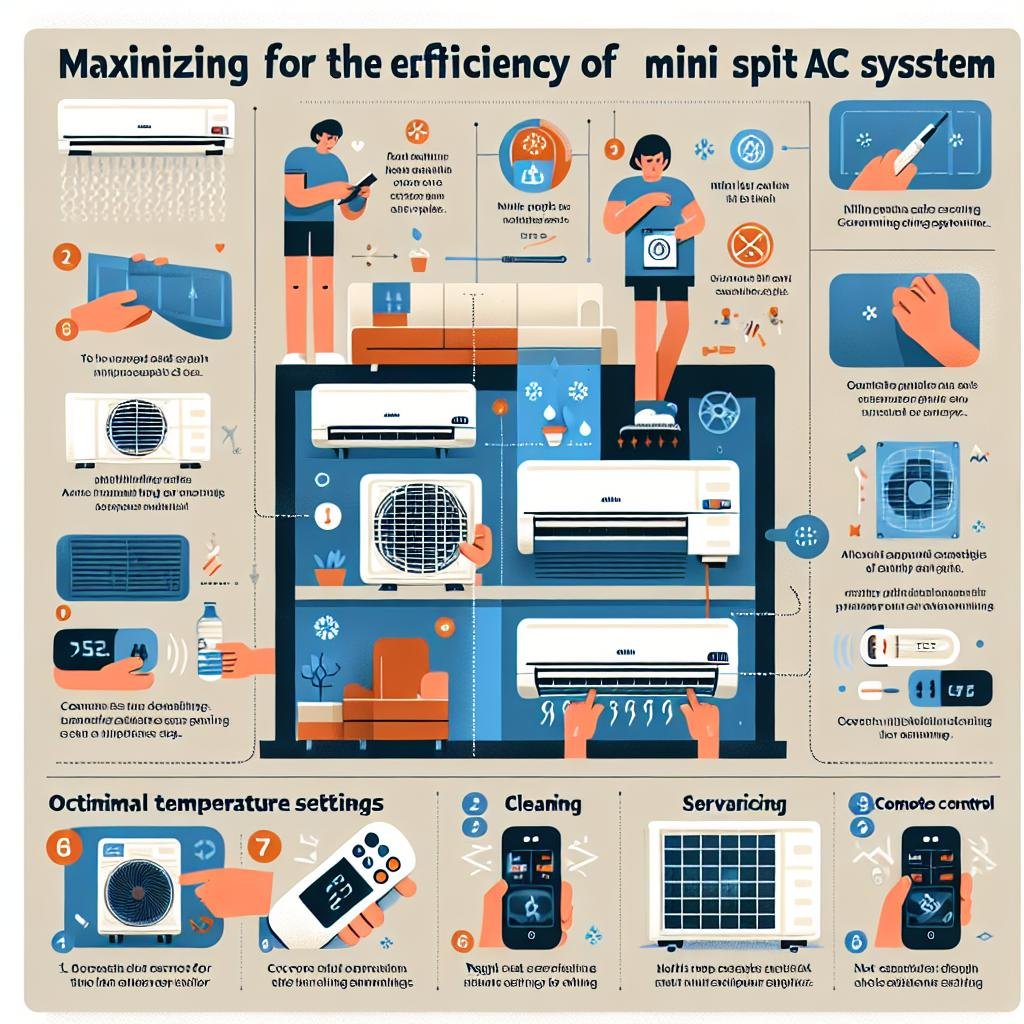Welcome to the world of mini split AC systems! If you’re new to the game and feeling a bit overwhelmed by all the technical jargon surrounding these efficient cooling systems, fear not. In this beginner’s guide, we’ll break down the mystery of efficiency ratings and help you navigate the world of mini splits with confidence. So grab a cup of tea, sit back, and get ready to become an efficiency rating pro!
Decoding SEER and HSPF: What Do They Really Mean?
Let’s delve into the acronyms of SEER (Seasonal Energy Efficiency Ratio) and HSPF (Heating Seasonal Performance Factor). These ratings are key players in determining the energy efficiency of mini split AC systems. SEER measures the cooling efficiency over a typical cooling season. Higher SEER ratings mean greater energy savings and reduced electricity bills. Picture this: You’re chillin’ in the hottest days of summer, but your AC’s energy consumption isn’t sky-high because it’s riding high on SEER!
On the flip side, HSPF takes the stage when your heating system is in action. This factor quantifies the heating efficiency, and similar to SEER, a higher HSPF score translates to more cost-effective operation during winter. To help you visualize:
| Rating | Ideal Range | Benefit |
|---|---|---|
| SEER | 16-23 | High Cooling Efficiency |
| HSPF | 8-10 | High Heating Efficiency |
- SEER: Essential for cooling efficiency
- HSPF: Crucial for heating efficiency
- Higher values signify better performance
The Impact of Efficiency Ratings on Your Energy Bills
When it comes to choosing a mini split AC system, understanding efficiency ratings can significantly reduce your energy bills. These ratings, often displayed as SEER (Seasonal Energy Efficiency Ratio) and HSPF (Heating Seasonal Performance Factor), help to gauge the system’s performance and energy consumption. Higher SEER and HSPF ratings mean more efficient operation, which translates to lower energy usage and costs. Not only do these ratings assist in choosing an eco-friendly and cost-effective solution, but they also help in deciphering long-term savings. Remember, an initially higher investment in a more efficient unit can result in substantial savings in the long run through reduced electricity bills.
Here’s a quick overview of how different SEER ratings might impact your expenses:
| SEER Rating | Monthly Energy Cost | Annual Saving |
|---|---|---|
| 14 | $120 | – |
| 16 | $100 | $240 |
| 20 | $80 | $480 |
Besides these tangible savings, opting for a higher rated mini split AC brings other benefits such as:
- Enhanced comfort: Better temperature regulation and quieter operation
- Eco-friendliness: Reduced carbon footprint due to lower energy consumption
- Increased lifespan: Efficient systems often come with advanced features leading to durability

Selecting the Right Efficiency Rating for Your Home
When choosing the best efficiency rating for your home, it’s essential to consider both SEER (Seasonal Energy Efficiency Ratio) and EER (Energy Efficiency Ratio). The SEER focuses on the unit’s performance over a typical cooling season, while the EER measures efficiency at a specific outdoor temperature (usually 95°F). A higher SEER rating often means the system will be more efficient, leading to lower electricity bills and a larger initial investment. Similarly, a higher EER rating provides excellent efficiency during peak times, beneficial in regions with extreme temperatures. Look for units that strike a balance between comfort and cost-effectiveness, being mindful of what’s best for your climate.
A beneficial way to navigate the world of mini-split AC efficiency is to make informed comparisons:
| Rating | Measurement | When to Consider |
|---|---|---|
| SEER | 12 – 25+ | Seasonal efficiency |
| EER | 8 - 12+ | Peak efficiency |
- Energy Savings: Higher ratings save more energy and money.
- Environmental Impact: More efficient units are eco-friendlier.
- Upfront Cost: Higher ratings often come at a higher price, but can be a wise investment.

Tips for Maximizing the Efficiency of Your Mini Split AC System
The key to getting the most out of your mini split AC unit lies in regular maintenance and mindful usage. Scheduling routine maintenance ensures that the unit is functioning at its best, reducing energy waste and expanding its lifespan. Consider performing the following tasks:
- Clean or replace filters every 3-6 months.
- Check the indoor and outdoor units for any blockages or debris.
- Inspect coolant lines for leaks or damage.
- Ensure proper airflow by keeping furniture and other items away from vents.
Additionally, using the system efficiently involves understanding how different settings and external factors affect its performance. For instance, setting the temperature a few degrees higher in summer or lower in winter can noticeably reduce energy consumption. Here’s a quick table for some seasonal temperature settings for optimal efficiency:
| Season | Temperature Setting |
|---|---|
| Summer | 24-26°C (75-78°F) |
| Winter | 20-22°C (68-72°F) |
By smartly adjusting your temperature settings and maintaining your mini split system, you can significantly improve its efficiency, leading to cost savings and a more comfortable living environment.
Q&A
### Q&A: Beginner’s Guide to Understanding the Efficiency Ratings of Mini Split AC Systems
Q: What exactly is a mini split AC system?
A: Great question! A mini split AC system is a type of air conditioning unit designed to provide targeted cooling (or heating) without the need for extensive ductwork. Think of it as the superhero of your home’s climate control, swooping in to save the day with efficiency and style. The system typically has two main components: an indoor air-handling unit and an outdoor compressor/condenser.
Q: Why should I worry about efficiency ratings?
A: Ah, efficiency ratings! They’re like the report cards for mini split systems, telling you how well these units perform. Higher efficiency means lower operating costs and a smaller carbon footprint. More money in your pocket and cleaner air? Sign me up!
Q: What are the common efficiency ratings I should know about?
A: There are a couple of key players:
-
SEER (Seasonal Energy Efficiency Ratio): This measures cooling efficiency over an entire season. Higher SEER numbers indicate better performance. Aim for 14 or higher if you want that gold star for energy savings.
-
HSPF (Heating Seasonal Performance Factor): If your mini split also provides heating, this rating tells you how efficiently it does so over a season. Look for HSPF ratings of 8 or higher for top-notch performance.
-
EER (Energy Efficiency Ratio): This evaluates the system’s efficiency at peak cooling times. Higher EER means more efficient cooling when you most need it.
Q: How do these ratings impact my utility bills?
A: Great point! Higher ratings mean your system uses less energy to produce the same amount of cooling or heating. Essentially, the higher the SEER, HSPF, and EER, the less you’ll shell out on your electricity bills. It’s like having your cake and eating it, too!
Q: Are higher efficiency ratings always better?
A: Not necessarily! While higher ratings usually mean better efficiency and lower bills, they often come with a higher upfront cost. It’s a balancing act: weigh the long-term savings against the initial investment. Think of it like upgrading to a fancy smartphone; sure, it costs more up front, but the bonus features (like an amazing camera or longer battery life) can make it worth every penny.
Q: How can I find the efficiency ratings of a mini split AC system?
A: Easy-peasy! The ratings are usually listed on the unit’s energy guide label, which is that bright yellow sticker that’s hard to miss. You can also find this info in the product specification sheet or on the manufacturer’s website. Make sure to do your homework before buying—your wallet and the planet will thank you!
Q: Are there any incentives for choosing a high-efficiency mini split AC system?
A: Absolutely! Many local utility companies and government programs offer rebates or tax incentives for installing energy-efficient systems. It’s like getting a bonus just for making a smart choice. Check with local resources to see what perks you might qualify for.
Q: What should I do next if I want to get a mini split AC system?
A: Step one: do your research on mini split systems and their efficiency ratings. Step two: compare models to find the best fit for your home and budget. Step three: consult with a professional installer to make sure you’re getting the right capacity and setup. And don’t forget to ask about any rebates or incentives—you’ll be chilling in comfort in no time!
By understanding efficiency ratings, you’re not just buying an AC system. You’re making a smart, eco-friendly investment in your comfort and energy savings. Cool, right?
In Retrospect
As we close the chapter on our “Beginner’s Guide to Understanding the Efficiency Ratings of Mini Split AC Systems,” we hope you’ve found a cool breeze of clarity wafting through your quest for energy efficiency. Navigating the world of SEERs, HSPFs, and EERs may have seemed like trekking through an alphabet jungle, but arm in arm, we’ve decoded the jargon to empower your next savvy home comfort decision.
Remember, a mini-split system is more than just a sleek piece of equipment; it’s an ally in your quest for comfort and sustainability. By understanding these efficiency ratings, you’re now equipped to not only keep your home at the perfect temperature but also to ease the strain on both the environment and your wallet.
So, as you venture forth into the realm of HVAC systems, may you do so with the confidence of a true efficiency aficionado. Cheers to your cool, cost-effective, and eco-friendly oasis! And remember, when in doubt, let the ratings guide the way. 🌿❄️

